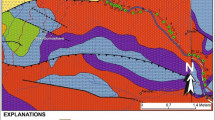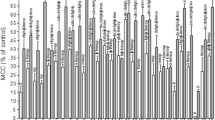Abstract
Some vascular plants are known to concentrate trace metals and are regarded to be suitable indicators of atmospheric metal deposition. Among plant species used for biogeochemical studies dandelion (Taraxacum officinale.) is convenient for monitoring air/soil pollution. The plant commonly occurs in different ecosystems with relatively parallel stages of ontogenesis over a broad area of geographical regions. Its leaves and roots are easily accessible for sampling. Leaf to root ratios of metal concentrations in dandelion may indicate the source of metals during the growing season. Trace metals in leaves and roots of dandelion from 132 sites in Poland showed higher concentrations in the plants from the SW region compared to those from the NE region of the country. However, the differences were only statistically significant (α = 0.05) for Cd, Ni, and Pb. Geometric means of metal concentrations (mg kg−1, air dried weight) in dandelion leaves of the SW and NE regions were: Cd 0.85, 0.52; Cr 0.99, 0.81; Cu 11.2, 11.1; Fe 184.4, 100.0; Mn 59.7, 51.4; Ni 2.1, 1.5; Pb 4.4, 3.0; and Zn 49.6, 41.3, respectively. Markedly higher concentrations of Cd, Pb, and Zn were found in the leaves of the dandelion over roots in the SW region. These metals are the most serious aerial pollutants in that part of the country.
Similar content being viewed by others
References
Brundin, N.V., Ek, J.I. and Selinus, O.C. 1987. Biogeochemical studies of plants from stream banks in northern Sweden.J. Geochem. Exploration,27, 157–186.
Djingova, R., Kuleff, I., Peuer, I. and Sansoni, B. 1986. Bromine, copper, manganese and lead content of the leaves ofTaraxacum officinale (dandelion).Sci. Total Environ.,50, 97–100; 197–208.
Jenkins, D. A. 1987. Trace elements in saxicolous lichens. In: Coughtrey, P.J., Martin, M.H. and Unsworth, M.H. (eds.),Pollutant Transport and Fate in Ecosystems, pp. 249–266. Blackwell Scientific Publications, Oxford.
Gough, L.P., Erdman, J.A. 1983. Baseline element concentrations for big sagebrush from western USA.J. Range Managent,36, 718–722.
Gough, L.P., McNeal, J.M. and Severson, R.C. 1980. Predicting native plant copper, iron, manganese, and zinc levels using DTPA and EDTA soil extractants, Northern Great Plains.Soil Sci. Soc. Am. J.,44, 1030–1036.
Kabata-Pendias, A., Galczynska, B. and Dudka, S. 1989. Baseline zinc content of soils and plants in Poland.Environ. Geochem. Health,11, 19–24.
Kabata-Pendias, A. and Pendias, H. 1991.Trace Elements in Soils and Plants. CRC Press, Boca Raton, Florida.
Kabata-Pendias, A. and Tarlowski, P. 1981. Impact of a copper smelter on agricultural environment. Part II. Contamination of herbage.Roczn. Glebozn.,32, 215–221.
Marchwinska, E., Kucharski, R. 1988. The state of agricultural soils pollution with metals in Katowice voievodship and possibilities of counteraction, In:Proceedings of Conference on Agriculture in Heavy Industry Agglomeration of Upper Silesia, pp. 43–53. Katowice (published in Polish).
Markert, B. and Weckert, V. 1989. Use ofPolytrichum formosum (moss) as a passive biomonitor for heavy metal pollution (cadmium, copper, lead and zinc).Sci. Total Environ.,86, 289–294.
Rhling, A., Rasmussen, L., Pilegaard, K., Makinen, A. and Steines, E. 1987.Survey of Atmospheric Heavy Metal Deposition in Nordic countries. Report for Nordic Council of Ministers, Kopenhavn.
Tidball, R.R. and Ebens, R.J. 1976. Regional geochemical baselines in soils of the Powder River Basin, Montana-Wyoming. In: Laudon, R.B. (ed.),Geology and Energy Resources of the Powder River Basin, 28th Annual Field Conf., pp. 299–310. Casper, WHO Guidebook.
Van Trump, G., Jr. and Miesch, A.T. 1977. The US Geological Survey RASS-STATPAC system for management and statistical reduction of geochemical data.Computer a. Geoscience,3, 475–488
Author information
Authors and Affiliations
Rights and permissions
About this article
Cite this article
Kabata-Pendias, A., Dudka, S. Trace metal contents ofTaraxacum officinale (dandelion) as a convenient environmental indicator. Environ Geochem Health 13, 108–113 (1991). https://doi.org/10.1007/BF01734301
Issue Date:
DOI: https://doi.org/10.1007/BF01734301




